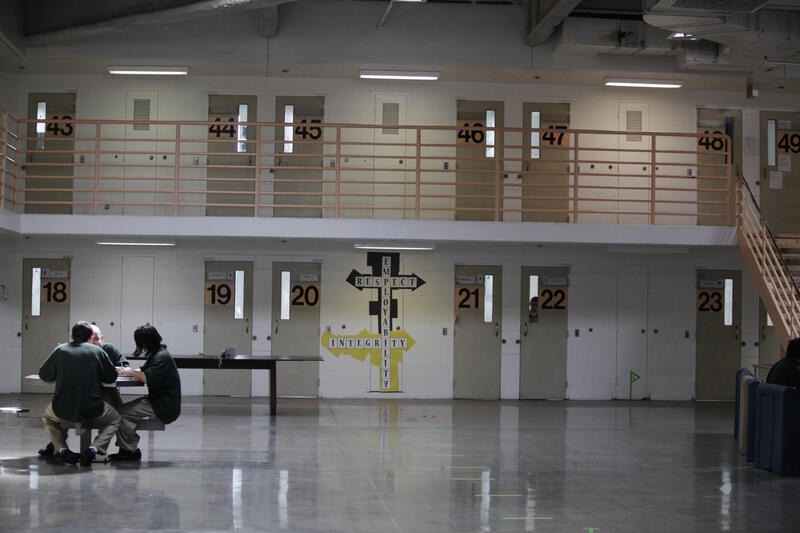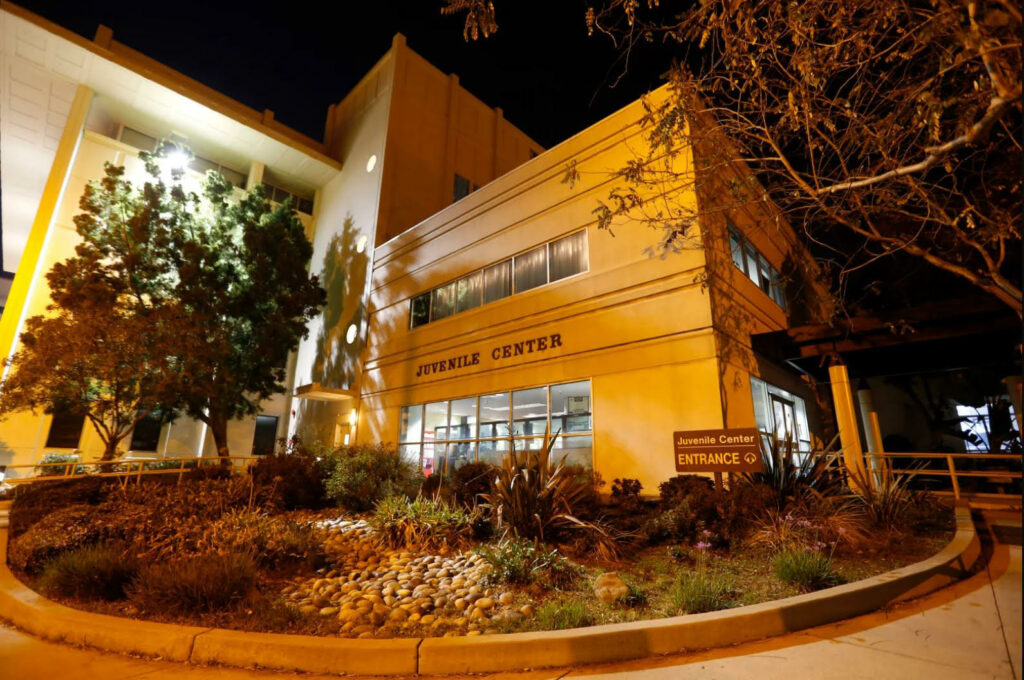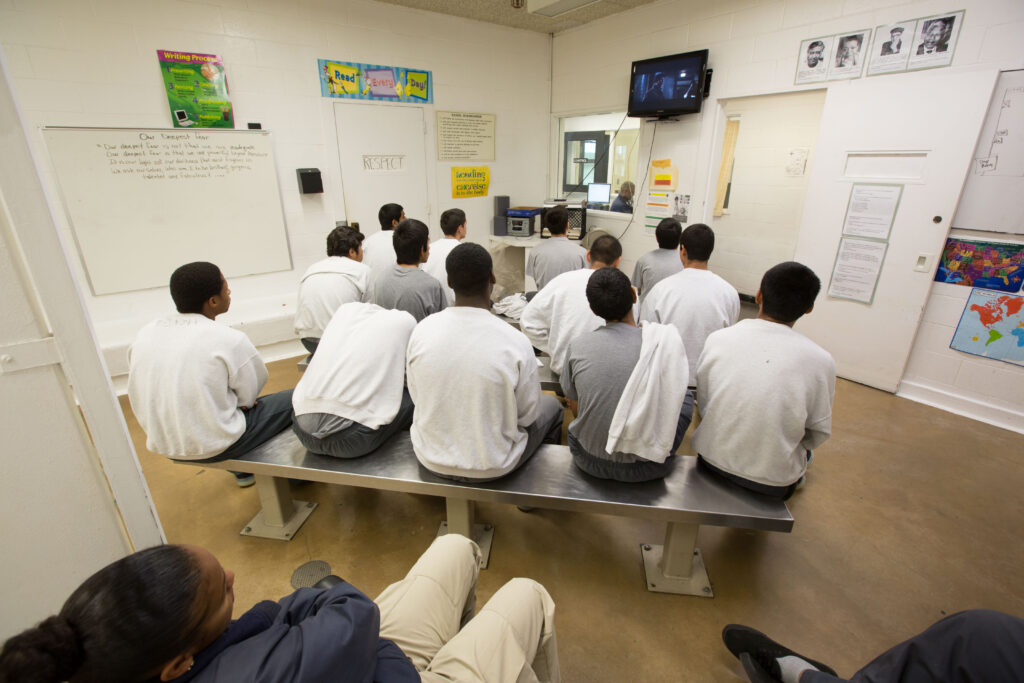
Wards at N.A. Chaderjian Youth Correctional Facility talk at a table in Merced Hall in Stockton, Calif.
Credit: Lea Suzuki / San Francisco Chronicle / Polaris
California is failing to provide a high-quality education to students in the juvenile justice system by not addressing the inadequacies of academic data collection practices, according to a recent report from the national Youth Law Center. Current collection practices, the report authors argue, do not accurately measure student needs and outcomes.
“A failure to design better metrics would be a disastrous choice on the part of California stakeholders to keep these students out of sight and out of mind,” the report’s authors wrote.
The report, “Out of Sight, Out of Mind,” is a follow-up to a 2016 report that similarly found the state to be failing in its mission of providing students in juvenile detention with high-quality education via its disproportionate representation of multiple student populations, high rates of chronic absenteeism, low high school graduation rates, inaccurate or incomplete data, and more.
The most recent report highlighted data from two school years — 2018-19 and 2021-22 — using publicly available data from the California Department of Education as well as public records requests sent to 10 county offices of education that oversee court schools, which are education facilities for youth in the juvenile justice system. Students enroll in court school as they await adjudication or disposition, after they’ve been committed to a juvenile facility, or if they’re in a home placement under the supervision of probation.
During 2018-19, nearly 20,000 students attended court schools in the state. In the 2021-22 school year, the number dropped to 10,891. This decrease likely reflects the lower number of youth in the juvenile justice system, which has trended downward in recent years, per the report.
California’s current academic data system does not capture one crucial data point — that the majority of students attend a court school for less than 31 instructional days, the report noted. This means that few students attend for an entire school year, which is typically the time frame that data collection practices are based on.
What’s more, currently available data does not distinguish between academic needs and outcomes of students who spend days or weeks attending a court school versus those who attend for years.
The report highlighted that it has long been anecdotally understood by researchers, probation staff and others working in education within the juvenile justice system that student attendance is often transitory given the dynamic nature of the legal system. The report’s authors argue that instructional programming should reflect this knowledge by calculating any partial credits earned by recording them in student transcripts once they leave juvenile detention. Students also need additional services to more seamlessly move back into their local schools.
While the report’s authors acknowledge that less time in the juvenile justice system is most beneficial, they maintain that the time youth do spend attending a court school should be as minimally disruptive as possible to their education. Minimizing disruption, they said, could include a heightened focus on the transition process out of juvenile detention.
An ongoing challenge with inadequate data collection is that improvements are difficult to highlight. For example, the report authors found that the college-going rate at 10 court schools exceeded the average for the state’s alternative schools.
“The data doesn’t really care if it’s positive or negative. The limitations exist on both sides,” said Chris Middleton, an Equal Justice Works fellow at the Youth Law Center and a primary author of the report. “And I think here where a really positive story could be told, there’s still a set of limitations that’s very evident.”
Much of the data contained in the report reflects a dire reality.
For example, the overall number of youth in the juvenile justice system decreased significantly from 2018 to 2022, yet the number of students with disabilities rose from 20.1% to 29.8%.
The report suggests a few potential reasons: improved screening and identification, improved communication between schools regarding disability status, or a failure to capitalize on the systemic changes that drove the decrease in youth detention statewide.
The report’s authors also found that foster youth are overrepresented in the juvenile justice system.
While foster youth represent less than 1% of all students enrolled in California schools, in 2018-19 they made up 21.44% of court school enrollments; by 2021-22, they were almost 31 times overrepresented in court schools versus traditional schools. This data was either redacted or unavailable for 27 of 51 court schools.
“The extremely high rate of disability status and the extremely high rate of foster care overlap,” Brady said. “We have long known that young people with disabilities are more likely to be impacted by the juvenile justice system. … The numbers for foster care were still surprising.”
Similarly, high rates of students experiencing homelessness were found at some court schools, but the data for this population of students was particularly unclear; much was either redacted or unavailable. While foster youth status is centrally tracked by the state, homelessness is largely screened by school districts — an identification process that has only in recent years improved through legislation and enforcement.
Regarding chronic absenteeism, the rate was 12.9% among court schools and 12.1% statewide during the 2018-19 school year, and by the 2021-22 school year, that rate was 16.8% among court schools and 30% statewide.
Though lower than the state average, this was alarming for the report’s authors.
Students who attend a local education agency for less than 31 days are not eligible to be considered chronically absent, which indicates that the true rate of chronic absences is much higher, given that most court school students attend for less than 31 instructional days, the report authors wrote.
Additionally, the authors found while some students refuse to attend class, some cannot attend due to decisions made by probation staff. Two examples shared in the report include a practice in Los Angeles County “of barring entire living units of young people from attending school if one of them misbehaved” and refusal by probation staff to provide “timely transport” of students to school.
According to the report, “A necessary element of addressing chronic absenteeism in court schools must include better documentation of missed instructional time and the reasons why students are absent from class.
“Additionally, efficient and effective coordination between probation and school staff is critical to ensuring the basic educational responsibility of students being present in their classrooms is met.”
While the rate of chronic absences was lower among court schools during the 2021-22 school year, it should be noted that the percentages across court schools varied. Some schools reported a rate of over 30% while other schools reported 0%.
One recent allocation of $15 million toward post-secondary education programs for youth in the juvenile justice system might turn the tide on better understanding outcomes. The funding will create and expand community college programming inside juvenile facilities, and a portion is intended to go toward evaluating such programs.
This ongoing funding “is the single most positive and exciting thing that’s going on in the area of juvenile justice and education right now,” said Lauren Brady, managing director of the legal team at Youth Law Center.
Many of the issues with data collection that researchers found were due to unavailable data or redactions — when a group includes fewer than 10 students, data is withheld to protect student privacy.
“We can’t tell the complete story. That’s where we’re at right now. … In order to truly transform the experience for students and to give them the best chance to have a brighter future, we have to be able to measure what they’re experiencing,” report co-author Middleton said. “And I think that we have the capability. I have faith in California and our institutions that we are able to properly develop these measures and ensure that the data’s actually being reported.”




